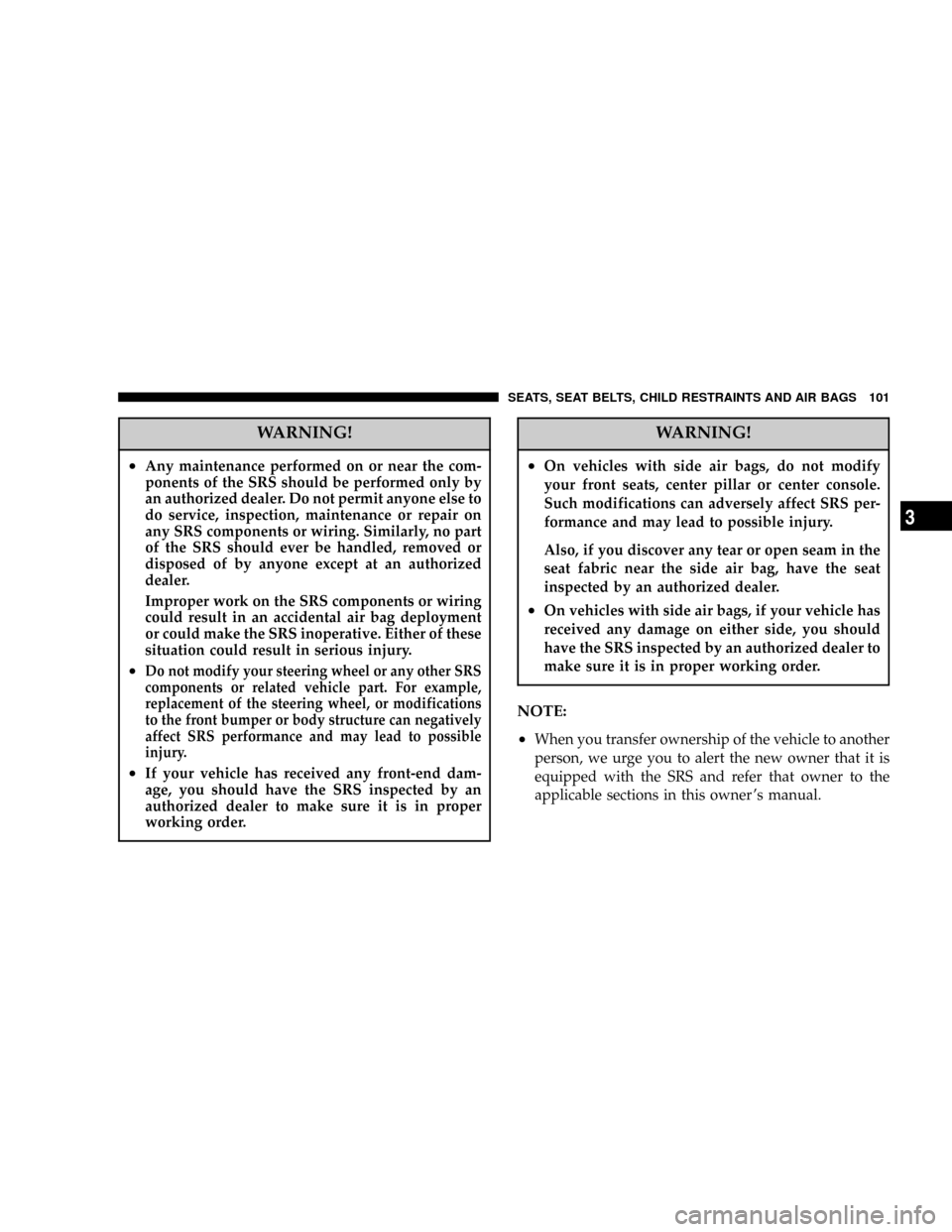2005 CHRYSLER SEBRING COUPE seats
[x] Cancel search: seatsPage 101 of 394

WARNING!
²Any maintenance performed on or near the com-
ponents of the SRS should be performed only by
an authorized dealer. Do not permit anyone else to
do service, inspection, maintenance or repair on
any SRS components or wiring. Similarly, no part
of the SRS should ever be handled, removed or
disposed of by anyone except at an authorized
dealer.
Improper work on the SRS components or wiring
could result in an accidental air bag deployment
or could make the SRS inoperative. Either of these
situation could result in serious injury.
²Do not modify your steering wheel or any other SRS
components or related vehicle part. For example,
replacement of the steering wheel, or modifications
to the front bumper or body structure can negatively
affect SRS performance and may lead to possible
injury.
²If your vehicle has received any front-end dam-
age, you should have the SRS inspected by an
authorized dealer to make sure it is in proper
working order.
WARNING!
²On vehicles with side air bags, do not modify
your front seats, center pillar or center console.
Such modifications can adversely affect SRS per-
formance and may lead to possible injury.
Also, if you discover any tear or open seam in the
seat fabric near the side air bag, have the seat
inspected by an authorized dealer.
²On vehicles with side air bags, if your vehicle has
received any damage on either side, you should
have the SRS inspected by an authorized dealer to
make sure it is in proper working order.
NOTE:
²
When you transfer ownership of the vehicle to another
person, we urge you to alert the new owner that it is
equipped with the SRS and refer that owner to the
applicable sections in this owner 's manual.
SEATS, SEAT BELTS, CHILD RESTRAINTS AND AIR BAGS 101
3
Page 102 of 394

²If you decide to junk or scrap your vehicle, we urge
you to first take it to an authorized dealer so that the
SRS can be made safe for disposal.
Caution label
Passenger restraint warning/caution labels for the SRS
are located in the vehicle as shown in the illustration.
Transporting Pets
Airbags deploying in the front seat could harm your pet.
An unrestrained pet will be thrown about and possibly
injured, or injure a passenger during panic braking or in
a collision.
Pets should be restrained in the rear seat in pet harnesses
or pet carriers that are secured by seat belts.
102 SEATS, SEAT BELTS, CHILD RESTRAINTS AND AIR BAGS
Page 143 of 394

mCruise/speed control....................189
NTo activate...........................190
NTo deactivate.........................194
NTo resume the set speed.................195
mTraction control (if so equipped)...........196
mCatalytic converter.....................197
mVehicle preparation before driving..........199
NSeat belts and seats....................199
NDefrosters...........................199
NTires...............................199NLights..............................200
NFluid leaks..........................200
NDriver..............................200
mSafe driving techniques..................200
mDriving, alcohol and drugs...............201
mTips for driving in various conditions........201
mOperation during cold weather............202
mTrailer Towing.........................203
NWarranty Requirements.................203
STARTING AND DRIVING 143
5
Page 199 of 394

8. Stop driving the vehicle if you think the performance
is noticeably less, or that there is unnecessary engine
miss, or any other engine trouble, such as with the
ignition, etc. If it is impractical to stop driving immedi-
ately, reduce the speed and drive for only a short time.
Have an inspection made by an authorized dealer as
soon as possible.
9. In an unusual event of a severe engine malfunction, a
scorching odor may indicate severe and abnormal cata-
lytic converter overheating. If this occurs, the vehicle
should be stopped in a safe place, the engine shut off and
the vehicle allowed to cool. Once the engine is cool, the
vehicle should immediately be taken to a dealer for
service.
VEHICLE PREPARATION BEFORE DRIVING
Before starting on a trip, perform the following checks to
obtain the greatest possible enjoyment and safety from
your vehicle:
Seat belts and seats
1. Before starting the vehicle, make certain that you and
all your passengers are seated and properly wearing the
seat belts (with children in the rear seat, in appropriate
restraints), and that all doors are locked.
2.
Adjust the driver's seat as far back as possible, while still
maintaining good visibility, and good control of the steering
wheel, brakes, accelerator, and controls. Examine the instru-
ment panel indicators for any possible malfunction.
3. Have the front passenger adjust their seat as far
rearward as possible.
Defrosters
Check operation by selecting the defroster mode and set
the blower switch for high speed operation. You should
be able to feel the air directed against the windshield.
(See ªHeater /Air conditioningº page 236.)
Tires
Examine all tires for excessive tread wear or uneven wear
patterns. Check for stones, nails, glass, or other objects
lodged in the tread. Inspect for tread cuts or sidewall
cracks.
STARTING AND DRIVING 199
5
Page 251 of 394

CLEANING THE INSIDE OF YOUR VEHICLE
After cleaning the inside of your vehicle with cleaner,
wipe it dry in a shady, well ventilated area.
CAUTION!
Do not use organic substances (solvents, kerosene,
alcohol, gasoline, etc.) or alkaline or acidic solutions.
These chemicals can cause discoloring, staining or
cracking of the surface.
If you use cleaners or polishing agents, make sure
their ingredients do not include the substances men-
tioned above.
NOTE: Always read the instructions on the cleaner
label.
Plastic, vinyl leather, fabric, and flocked parts
1. Lightly wipe with a soft cloth soaked in a 3% solution
of neutral detergent and water.2. After using detergent, dip the cloth in fresh water and
wring out well. Using this cloth, wipe off the detergent
thoroughly.
NOTE: Cleaners, conditioners, and protectants contain-
ing silicons or waxes may cause annoying reflections and
obscure vision.
Upholstery
1. To maintain the value of your new vehicle, maintain
the upholstery carefully and keep the interior clean.
Use a vacuum cleaner and brush to clean the seats. If
stained, vinyl and synthetic leather should be cleaned
with an appropriate cleaner. Cloth fabrics can be cleaned
with either upholstery cleaner or a 3% solution of neutral
detergent in lukewarm water.
2. Clean the carpeting with a vacuum cleaner and re-
move any stains with carpet cleaner. Oil and grease can
be removed by lightly dabbing with a clean colorfast
cloth and spot remover.
NOTE: If fuzzing is difficult to remove from the seat
upholstery, draw a suitable defuzzing brush over the
surface in one direction.
VEHICLE CARE 251
7
Page 252 of 394

Genuine leather (if so equipped)
1. Lightly wipe with a soft cloth soaked in a 5% solution
of neutral detergent and water.
2. Dip the cloth in fresh water and wring it out well.
Using this cloth, wipe off the detergent thoroughly.
3. Apply a leather protecting agent to the genuine leather
surface.
NOTE
1. If genuine leather is wet with water, wipe off the water
as quickly as possible with a dry, soft cloth.
2. Slight stains on genuine leather may be removed with
a leather cleaner.
3. The genuine leather surface may be damaged if a
nylon brush is rubbed hard against it.
4. Organic solvents such as benzine, alcohol, gasoline,
acid or alkaline solvents may discolor the genuine leather
surface and should not be used.
5. Dirty genuine leather seats may mildew. Be very
careful about oil stains and remove them immediately.6. The genuine leather surface may harden and shrink if
it is exposed to the direct rays of the sun for long hours.
When your vehicle is parked, place it in the shade as
much as possible.
7. When the temperature of the vehicle interior rises in
the summer, vinyl products left on the genuine leather
seat may deteriorate and stick to the seat.
CLEANING THE OUTSIDE OF YOUR VEHICLE
To protect your vehicle's outside finish, it is important
that you wash it often and thoroughly. If desired, you
may wax your vehicle by using an automobile wax.
Foreign material
Industrial fallout, road tar, bird droppings, tree sap,
insect remains, sea water, and other foreign matter can
damage the finish of your vehicle.
Generally, the longer the foreign material remains in
contact with the outside finish the more extensive the
damage. Wash your vehicle as soon as possible if it
becomes contaminated with foreign material.
252 VEHICLE CARE
Page 339 of 394

2. Maintain wheel balance and front suspension align-
ment.
3. Rotate tires regularly in accordance with the recom-
mendation in the section ªTire rotationº on page 344.
Loading information
WARNING!
Overloading of your tire is dangerous. Overloading
can cause tire failure, affect vehicle handling, and
increase your stopping distance. Use tires of the
recommended load capacity for your vehicle. Never
overload them.
It is important to familiarize yourself with the following
terms before loading your vehicle:
²Vehicle maximum load on the tire : load on an
individual tire that is determined by distributing to
each axle its share of the maximum loaded vehicle
weight and dividing by two.
²Vehicle normal load on the tire : load on an indi-
vidual tire that is determined by distributing to each
axle its share of the curb weight, accessory weight,
and normal occupant weight and dividing by two.
²Maximum loaded vehicle weight : the sum of -
(a) Curb weight;
(b) Accessory weight
(c) Vehicle capacity weight; and
(d) Production option weight.
²Curb weight : the weight of a motor vehicle with
standard equipment including the maximum capac-
ity of fuel, oil, and coolant, and, if so equipped, air
conditioning and additional weight optional engine.
²Accessory weight : the combined weight (in excess
of those standard items which may be replaced) of
automatic transmission, power steering, power
brakes, power windows, power seats, radio, and
heater, to the extent that these items are available as
factory-installed equipment (whether installed or
not).
MAINTENANCE 339
9
Page 392 of 394

Odometer..........................106,110
Oil pressure gauge...................... 106
Oil pressure warning light.............107,114
Oil
Engine oil........................... 314
Onboard Diagnostic System............... 310
Opener, Garage Door.................... 132
Operation during cold weather............. 202
Operation under adverse driving conditions . . . 261
Overdrive indicator..................... 107
Oversize tires.......................... 338
Owner 's Manual....................... 383
Parking brake
Operating method.................... 169
Parking brake lever stroke.............. 330
Polishing............................. 256
Power brakes.......................... 172
Power door locks........................ 34
Power windows......................... 43
Proper shift points...................... 167
Puncture (tire changing).................. 272Radial ply tires........................ 337
Radiator cap.....................307,318,319
Radio................................ 219
General information................... 216
Reading lamps......................... 131
Reading light.......................... 131
Rear seats............................. 66
Rear window defroster................... 125
Replacement of light bulbs................ 291
Reporting Safety Defects................. 381
Safe driving techniques.................. 200
Scheduled maintenance.................. 346
Seat belt extender....................... 75
Seat Belts
Adjustable seat belt anchor.............73,80
And Pregnant Women.................. 87
Child restraint........................ 76
Maintenance and inspection.............. 88
Seat belt extender...................... 75
Seat belt reminder/warning light......... 107
UNIBELT restraint system............... 69
Seatback.............................. 60
392 INDEX